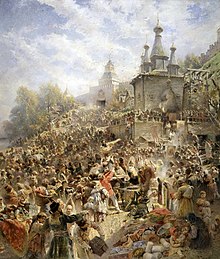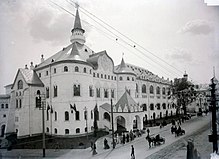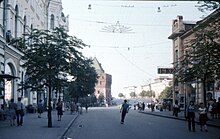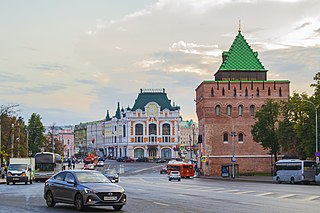
Nizhny Novgorod is the administrative centre of Nizhny Novgorod Oblast and the Volga Federal District in Russia. The city is located at the confluence of the Oka and the Volga rivers in Central Russia, with a population of over 1.2 million residents, up to roughly 1.7 million residents in the urban agglomeration. Nizhny Novgorod is the sixth-largest city in Russia, the second-most populous city on the Volga, as well as the Volga Federal District. It is an important economic, transportation, scientific, educational and cultural center in Russia and the vast Volga-Vyatka economic region, and is the main center of river tourism in Russia. In the historic part of the city there are many universities, theaters, museums and churches.

GAZ or Gorkovsky avtomobilny zavod is a Russian automotive manufacturer located in Nizhny Novgorod, formerly known as Gorky (Горький) (1932–1990). It is the core subsidiary of GAZ Group Holding, which is itself part of Basic Element industrial group. JSC Russian Machines is the controlling shareholder in OAO GAZ.
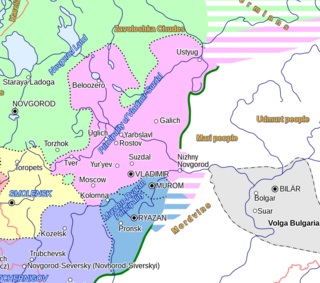
Vladimir-Suzdal, formally known as the Principality of Vladimir-Suzdal or Grand Principality of Vladimir (1157–1331), also as Suzdalia or Vladimir-Suzdalian Rus', was one of the major principalities emerging from Kievan Rus' in the late 12th century, centered in Vladimir-on-Klyazma. With time the principality grew into a grand principality divided into several smaller principalities. After being conquered by the Mongol Empire, the principality became a self-governed state headed by its own nobility. A governorship of the principality, however, was prescribed by a jarlig issued from the Golden Horde to a Rurikid sovereign.

Dmitry Mikhaylovich Pozharsky was a Russian prince known for his military leadership during the Polish–Muscovite War from 1611 to 1612. Pozharsky formed the Second Volunteer Army with Kuzma Minin in Nizhny Novgorod against the Polish–Lithuanian Commonwealth's occupation of Russia during the Time of Troubles, resulting in Polish withdrawal after Russian victory at the Battle of Moscow in 1612. Pozharsky received the unprecedented title of Saviour of the Fatherland from Mikhail I of Russia, becoming a folk hero in Russian culture and honored in the Monument to Minin and Pozharsky in Moscow's Red Square.

Gorodets is a town and the administrative center of Gorodetsky District in Nizhny Novgorod Oblast, Russia, located on the left bank of the Volga River, 53 kilometers (33 mi) northwest of Nizhny Novgorod, the administrative center of the oblast. Population: 30,658 (2010 Census); 32,442 (2002 Census); 34,210 (1989 Census); 34,000 (1970).

Kuzma Minin, full name Kuzma Minich Zakhariev-Sukhoruky, was a Russian merchant who, together with Prince Dmitry Pozharsky, formed the popular uprising in Nizhny Novgorod against the Polish–Lithuanian Commonwealth's occupation of Russia during the Polish intervention in Russia (1605-1618) coinciding with the Time of Troubles. The popular uprising ultimately led to Russian victory at the Battle of Moscow and the end of Polish occupation in 1612. Minin and Pozharsky become national heroes in Russian culture and were honored in the Monument to Minin and Pozharsky in Moscow's Red Square.

The Monument to Minin and Pozharsky is a bronze statue designed by Ivan Martos and located on the Red Square in Moscow, Russia, in front of Saint Basil's Cathedral. The statue commemorates two Russian national heroes Prince Dmitry Pozharsky and Kuzma Minin, who in 1612 organized a popular uprising that ultimately led to the end of the Polish occupation of Moscow during Polish intervention in Russia, thus putting an end to the Time of Troubles.

The Nizhny Novgorod Metro, formerly known as the Gorky Metro, is a rapid-transit system which serves the city of Nizhny Novgorod, Russia. Opened in 1985, it consists of 15 stations and is 21.6 kilometres (13.4 mi) long. The metro connects with the City Rail and Nizhny Novgorod Central Diameters systems at the Moskovskaya station. It has the third-largest number of stations of any Russian subway system, the largest two being Moscow and St. Petersburg.

Krasnoye Sormovo Shipyard No. 112 named after Andrei Zhdanov is one of the oldest shipbuilding factories in Russia, located in the Sormovsky City District of Nizhny Novgorod.
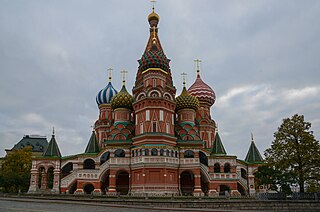
The Russo-Kazan Wars was a series of wars fought between the Grand Principality of Moscow and the Khanate of Kazan from 1437, until Kazan was finally conquered by the Tsardom of Russia under Ivan the Terrible in 1552.

Sormovsky City District, or Sormovo, is one of the eight districts of the city of Nizhny Novgorod, Russia. It occupies the northwestern corner of the city, adjacent to the Volga River. Population: 168,761 (2010 Census); 177,940 (2002 Census); 185,994 (1989 Census).

The Principality of Nizhny Novgorod-Suzdal, also known as Suzdal-Nizhny Novgorod, was a principality formed in 1341. Its main towns were Nizhny Novgorod, Suzdal, Gorokhovets, Gorodets, and Kurmysh. Nizhny Novgorod was the seat of the principality from 1350. The prince Dmitry of Suzdal obtained the yarlik (patent) for the title of Grand Prince of Vladimir from khan Nawruz Beg in 1360.

The Nizhny Novgorod Kremlin is a fortress (kremlin) in the historic city center of Nizhny Novgorod, Russia.

Vasily Demitryvich Kirdyapa was the eldest son of Dmitri Konstantinovich of Suzdal and Nizhny Novgorod, a Prince of Suzdal (1364–1382) and Gorodets (1387–1403). He was the ancestor of the senior branch of a Rurikid noble family, and the Princes Shuysky.
The following is a timeline of the history of the city of Nizhny Novgorod, Russia.

The Alexander Nevsky Cathedral is a Russian Orthodox cathedral church located in the Kanavinsky city district of Nizhny Novgorod. The cathedral is located on the former territory of the Nizhny Novgorod Fair. It is one of the unofficial symbols of Nizhny Novgorod, along with the Dmitrovskaya Tower of the Kremlin, the Chkalov staircase and the fair.
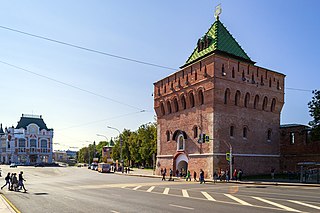
The Minin and Pozharsky Square, also known as just Minin Square, is the main square of Nizhny Novgorod. It is a social and cultural center of the city, the venue of the most important celebrations. It is located in the historical centre of the old town from the southeast side of the Kremlin.

The bombing of Gorky by the German Luftwaffe was the most destructive attack on Soviet war production on the Eastern Front in World War II. It lasted intermittently from October 1941 - June 1943, with 43 raids carried out.

The Chkalov Stairs is a monumental flight of steps in the center of Nizhny Novgorod, connecting Minin and Pozharsky Square, the Upper Volga and the Lower Volga embankments. It was built by the architects Alexander Yakovlev, Lev Rudnev and Vladimir Munts. It is the longest staircase in Russia. The staircase starts from the monument to Chkalov, near the St. George's Tower of the Kremlin. It is built in the form of a figure of eight and consists of 560 steps, if you count it both sides. The number of steps from the bottom to the top is 442 on the right. In the intersections of the side slopes there are two observation platforms. At the bottom of the stairs is a monument to the boat "Hero", which is located at the Lower-Volga embankment.
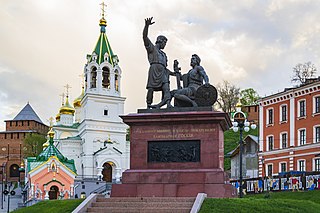
The Monument to Minin and Pozharsky is a copy of the monument erected on Red Square in Moscow. The monument is located in the historic centre of Nizhny Novgorod on National Unity Square, under the walls of the Kremlin, near the Church of St. John the Baptist.





